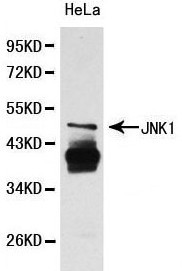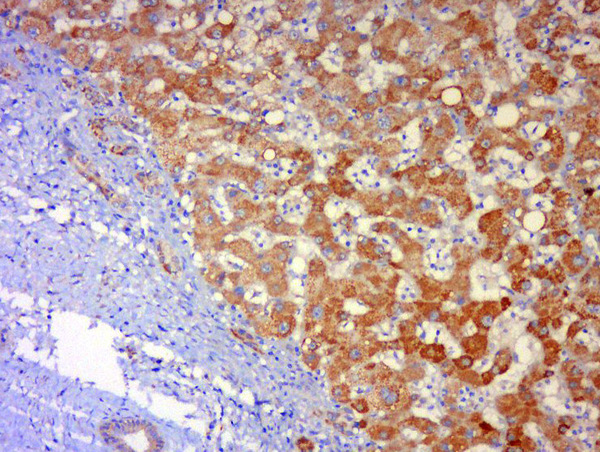
Figure 1. Western blot analysis of JNK1/2/3 using anti-JNK1/2/3 antibody (M02608-1). Electrophoresis was performed on a 5-20% SDS-PAGE gel at 70V (Stacking gel) / 90V (Resolving gel) for 2-3 hours. The sample well of each lane was loaded with 30 ug of sample under reducing conditions. Lane 1: human Hela whole cell lysates, Lane 2: human U87 whole cell lysates, Lane 3: human A549 whole cell lysates, Lane 4: rat PC-12 whole cell lysates, Lane 5: rat C6 whole cell lysates, Lane 6: mouse Neuro-2a whole cell lysates, Lane 7: mouse NIH/3T3 whole cell lysates. After electrophoresis, proteins were transferred to a nitrocellulose membrane at 150 mA for 50-90 minutes. Blocked the membrane with 5% non-fat milk/TBS for 1.5 hour at RT. The membrane was incubated with rabbit anti-JNK1/2/3 antigen affinity purified monoclonal antibody (Catalog # M02608-1) at 1:1000 overnight at 4°C, then washed with TBS-0.1%Tween 3 times with 5 minutes each and probed with a goat anti-rabbit IgG-HRP secondary antibody at a dilution of 1:500 for 1.5 hour at RT. The signal is developed using an Enhanced Chemiluminescent detection (ECL) kit (Catalog # EK1002) with Tanon 5200 system. A specific band was detected for JNK1/2/3 at approximately 40, 48 kDa. The expected band size for JNK1/2/3 is at 48 kDa.
Anti-JNK1/2/3 Rabbit Monoclonal Antibody
M02608-1
ApplicationsImmunoFluorescence, ImmunoPrecipitation, Western Blot, ImmunoCytoChemistry
Product group Antibodies
ReactivityHuman, Mouse, Rat
TargetMAPK8
Overview
- SupplierBoster Bio
- Product NameAnti-JNK1/2/3 Rabbit Monoclonal Antibody
- Delivery Days Customer9
- ApplicationsImmunoFluorescence, ImmunoPrecipitation, Western Blot, ImmunoCytoChemistry
- CertificationResearch Use Only
- ClonalityMonoclonal
- Clone IDDFI-13
- Gene ID5599
- Target nameMAPK8
- Target descriptionmitogen-activated protein kinase 8
- Target synonymsJNK, JNK-46, JNK1, JNK1A2, JNK21B1/2, PRKM8, SAPK1, SAPK1c, mitogen-activated protein kinase 8, JUN N-terminal kinase, MAP kinase 8, c-Jun N-terminal kinase 1, stress-activated protein kinase 1, stress-activated protein kinase 1c
- HostRabbit
- IsotypeIgG
- Protein IDP45983
- Protein NameMitogen-activated protein kinase 8
- Scientific DescriptionBoster Bio Anti-JNK1/2/3 MAPK8 Rabbit Monoclonal Antibody catalog # M02608-1. Tested in WB, ICC/IF, IP applications. This antibody reacts with Human, Mouse, Rat.
- ReactivityHuman, Mouse, Rat
- Storage Instruction-20°C
- UNSPSC12352203
References
- Zhou CC, He YQ, Qiu YS, et al. Zinc supplementation ameliorates sorafenib-induced cognitive impairment through ROS/JNK signaling pathway. Biol Trace Elem Res. 2023,201(1):324-337. doi: 10.1007/s12011-022-03142-5Read this paper
- Wang Y, Zhao H, Liu Y, et al. Zinc exerts its renal protection effect on arsenic-exposed common carp: A signaling network comprising Nrf2, NF-κB and MAPK pathways. Fish Shellfish Immunol. 2020,104:383-390. doi: 10.1016/j.fsi.2020.06.031Read this paper
- Han H, Wang H, Du Y, et al. Grape Seed Procyanidins Attenuates Cisplatin-induced Human Embryonic Renal Cell Cytotoxicity by Modulating Heme Oxygenase-1 in Vitro. Cell Biochem Biophys. 2019,77(4):367-377. doi: 10.1007/s12013-019-00890-5Read this paper
- Zhao H, Wang Y, Liu J, et al. The cardiotoxicity of the common carp (Cyprinus carpio) exposed to environmentally relevant concentrations of arsenic and subsequently relieved by zinc supplementation. Environ Pollut. 2019,253:741-748. doi: 10.1016/j.envpol.2019.07.065Read this paper
- Shangguan Y, Jiang H, Pan Z, et al. Glucocorticoid mediates prenatal caffeine exposure-induced endochondral ossification retardation and its molecular mechanism in female fetal rats. Cell Death Dis. 2017,8(10):e3157. doi: 10.1038/cddis.2017.546Read this paper
- Li Y, He S, Tang J, et al. Andrographolide Inhibits Inflammatory Cytokines Secretion in LPS-Stimulated RAW264.7 Cells through Suppression of NF-κB/MAPK Signaling Pathway. Evid Based Complement Alternat Med. 2017,2017:8248142. doi: 10.1155/2017/8248142Read this paper
- Bu X, Zhao Y, Zhang Z, et al. Recombinant Newcastle disease virus (rL-RVG) triggers autophagy and apoptosis in gastric carcinoma cells by inducing ER stress. Am J Cancer Res. 2016,6(5):924-36.Read this paper
- Wang X, Jiang Q, Wang W, et al. Molecular mechanism of polypeptides from Chlamys farreri (PCF)'s anti-apoptotic effect in UVA-exposed HaCaT cells involves HSF1/HSP70, JNK, XO, iNOS and NO/ROS. J Photochem Photobiol B. 2014,130:47-56. doi: 10.1016/j.jphotobiol.2013.11.005Read this paper
- Ding Y, Zou J, Li Z, et al. Study of histopathological and molecular changes of rat kidney under simulated weightlessness and resistance training protective effect. PLoS One. 2011,6(5):e20008. doi: 10.1371/journal.pone.0020008Read this paper








